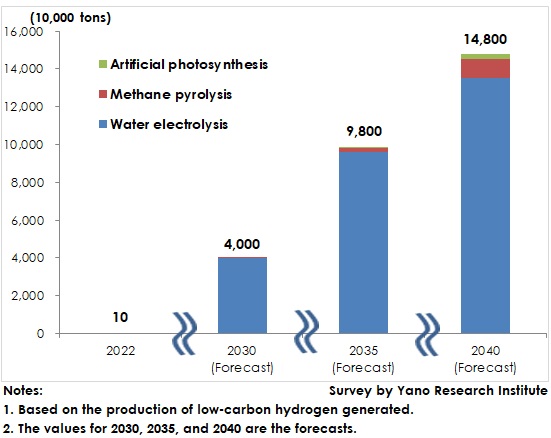No.3424
Global Market of Hydrogen Production Technologies and Components: Key Research Findings 2023
Global Production of Low-Carbon Hydrogen Projected to Reach 148,000 Thousand Tons by 2040
Yano Research Institute (the President, Takashi Mizukoshi) has surveyed the global market of hydrogen production technologies and components and has identified the policies on hydrogen at major countries and regions, as well as development trends in market players and R&D institutions. Here discloses the forecast on global production of low-carbon hydrogen.

Market Overview
In recent years, to realize carbon neutrality, formulation of strategies and legislation related to hydrogen has been underway around the world, which has accelerated the investment to research and development on hydrogen production technologies by public and private sectors and the support to supply chain verification business and hydrogen applications.
Japan is one of them, updating its Basic Hydrogen Strategy in June 2023. Regarding innovative research and development for production, transport, storage, and utilization of hydrogen at each industrial segment foreseeing 2050, the revised Basic Hydrogen Strategy has suggested to mediate between enterprises and R&D institutions including universities for the outcome of research and development, and to address social implementation of hydrogen by public and private sectors. For hydrogen production, three technologies are mentioned, i.e., 1) water electrolysis that is highly efficient, durable, and low cost, 2) pyrolysis of methane or other heat sources such as high-temperature gas furnace, etc., and 3) utilization of photocatalysts.
This research has covered the above-mentioned three methods as innovative hydrogen production technologies based on the revised Basic Hydrogen Strategy and has defined low-carbon hydrogen as the hydrogen generated either from these technologies.
As large-scale verification business on water electrolysis equipment has already been started at each country, the global production of low-carbon hydrogen in 2022 is estimated to be 100,000 tons. The social implementation of methane pyrolysis is likely to be after 2030, and that of artificial photosynthesis to be around 2035. Estimated from R&D trends and plant establishment for both technologies, the global production of low-carbon hydrogen is projected to reach 40 million tons by 2030, 98 million tons by 2035, and 148 million tons by 2040.
Noteworthy Topics
Hydrogen-Related Policy in Japan
Japan sets the target of hydrogen supply cost to 20 yen per Nm3 or less, and of hydrogen introduction to the level of annual 20 million tons, both by 2050.
The revised Basic Hydrogen Strategy has targeted the introduction of water electrolysis equipment by Japanese companies (including some manufacturers of components and materials) in Japan and other countries to around 15GW by 2030, thereby to address establishing the foundation of hydrogen production. To achieve this, the strategy has indicated that it would consider governmental support for expanding manufacturing capacity of water electrolysis equipment and components.
It plans that the investment to build a large-scale supply chain structure for hydrogen and ammonia by the public and private sectors exceeds 15 trillion yen in 15 years.
Future Outlook
Hydrogen production using renewable resource is highly valued in Europe and in the U.S. due to non-emission of GHG. While striving to expand the supplies of already abundant renewable energy and reinforce transmission network, the roadmap to reduce the cost for supplying green hydrogen by using low-cost, renewable-energy electricity including excess electricity seems to be the common denominator in countries around the world.
Meanwhile, Japan suffers from belated renewable energy deployment and high electricity costs in the first place, which have prevented from spreading of hydrogen production technologies. The Basic Hydrogen Strategy is to be reviewed at appropriate frequency, such as once in five years. Hereafter, it is required to demonstrate a system to be created for achieving domestic supply of excess renewable energy in volume at low price.
Research Outline
2.Research Object: Companies and R&D institutions addressing pragmatic use of hydrogen production technologies
3.Research Methogology: Face-to-face interviews (including online) by expert researchers and literature research
Low-Carbon Hydrogen
Low-carbon hydrogen is the hydrogen generated by the following, innovative three types of production technologies, i.e., water electrolysis (alkaline, polymer electrolyte membrane or proton exchange membrane [PEM], anion exchange membrane [AEM], solid oxide electrolysis cell [SOEC]), methane pyrolysis, and artificial photosynthesis. (*)
* For reference, please see our press release “Global Artificial Photosynthesis Market: Key Research Findings 2022” on 19 October 2022.
https://www.yanoresearch.com/en/press-release/show/press_id/3113:
<Products and Services in the Market>
Low-carbon hydrogen, hydrogen production equipment and related components (
Published Report
Contact Us
The copyright and all other rights pertaining to this report belong to Yano Research Institute.
Please contact our PR team when quoting the report contents for the purpose other than media coverage.
Depending on the purpose of using our report, we may ask you to present your sentences for confirmation beforehand.